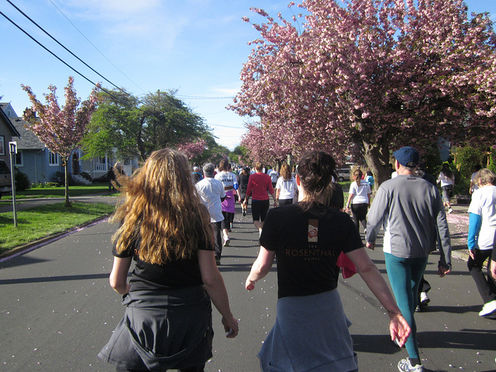
The US Surgeon General last week issued another call to action to get his nation walking. Faced with the fact that 50% of the US adult population (a statistic replicated in other western countries) suffers from chronic disease or cancer, he has argued that any increase in activity is going to bring significant public health benefits. Walking represents one of the easiest and most effective ways of achieving this goal.
Getting people walking has proved a challenge
Although this sounds fairly easy in principle, getting people to do more exercise through walking is something that has been at the heart of public health policy in a major form since the publication ofphysical activity guidelines in 2008. These guidelines advocated at least 2.5 hours a week of moderate intensity physical activity, such as brisk walking. This target is echoed by the UK’s physical activity guidelines and those in Australia.
The potential benefits in terms of improved public health are clear, if you consider that only 54% of adult men and 46% of adult women in the US meet the physical activity goal. Worse still, 28% or men and 32% of women reported that they had not done any physical activity that lasted more than 10 minutes in the previous week of being asked.
Getting people walking at the right level of intensity is even harder
Getting people to walk the minimum amount of time is a major challenge. The even bigger challenge comes with the part of the advice that is often ignored or simply not known or understood. In order for their to be a health benefit, the pace at which the walking is done needs to be above a certain intensity.
Although not specifically mentioned in the US Surgeon General’s “Step it Up” programme to promote walking, wearables such as those from Jawbone, Fitbit and others, are one way of tracking the number of steps walked in a day. For most users of these devices, the focus is on getting to the magical 10,000 steps a day. This isn’t really the best target to use however as to achieve the intensity guidelines to achieve a health benefit, it is only the steps that were above a certain pace that count.
How activity intensity is measured
To measure activity intensity, a measure called the Metabolic Equivalent, or MET, is used. 1 MET is the amount of energy consumed by a person at rest (or watching television for example). Moderate intensity activity is defined as activity that is between 3 – 5.9 METs of energy expenditure. This in turn equates to walking at a pace of 4.8 km per hour (3 miles per hour).
Devices like those from Fitbit track activities at, or above, this level activity as “active minutes”. The target is set at 30 minutes a day and is recorded only if the wearer does more than 10 minutes at this intensity.
The accuracy of wearables to estimate METs is improved if they have a heart rate monitor built in.
Recommended activity using METs
It has been recommended that a person does between 500 to 1,000 METs a week to get health benefits. The argument goes that the more METs are expended, the greater the benefit. The recommendations of 2.5 hours a week only gets the walker to the bottom of this range and so theoretically, doing 5 “active” hours of walking would be better.
However, there may be evidence that not all health benefits actually do respond to increased levels of activity in a “linear” fashion. In other words, some benefits may plateau after a certain level of activity.
The problem with the evidence
The problem with a large amount of the research done in the area of health benefits of walking is that it has been done using surveys and self-reporting which is notoriously inaccurate. Very few studies have been conducted using the “randomised controlled trial” approach to this type of scientific investigation using objective measures of activity that even consumer wearables can now provide.
As at least the US Surgeon General has made clear in his call to action, much more research is needed. Not only to make the evidence for the exact nature of the benefits clear, but also to investigate how people can be persuaded to start and stick with a programme of walking to achieve the recommended amounts of exercise. Although walking results in fewer injuries than say, running, it is not completely free of risk and so this is another area that requires more research.
In the meantime
In the meantime, if you have a Fitbit (or other wearable), concentrate on the active minute target and less on the number of steps. Aim to get between 2.5 and 5 hours of active walking done a week. If you don’t have a wearable pedometer, another way of measuring the right level of intensity when walking is that you should have enough breath to be able to talk to someone but not be able to sing.
Disclosure
David Glance works in the area of promoting activity using wearables and also owns shares in Fitbit.
